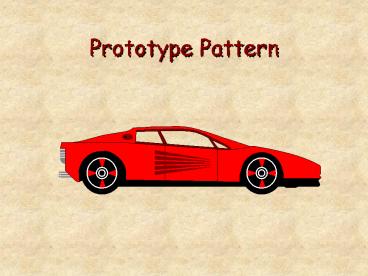Prototype Pattern PowerPoint PPT Presentation
Title: Prototype Pattern
1
Prototype Pattern
2
Creational Pattern
- Specify the kinds of objects to create using a
prototypical instance, and create new objects by
copy this prototype.
3
Problem
Problem The GraphicTool class
belongs to the framework, while the graphical
classes are application-specific, so the
GraphicTool class doesn't know how to create
graphical objects and then operate on them.
4
Solution One
This method will produce many subclasses that are
different only in the kind of music objects they
instantiated.
5
Solution Two
6
Structure
- Participants
- Prototype(Graphic)
- declares an interface for cloning itself.
- ConcretePrototype
- (Staff,WholeNote,
- HalfNote)
- implements an operation for cloning itself.
- Client(GraphicalTool)
- - creates a new object by asking a prototype to
clone itself.
7
Applicability
- The prototype pattern is used when a system
should be independent of how its products are
created, composed, and represented and - when the classes to instantiate are specified at
run-time for example, the dynamic loading - to avoid building a class hierarchy of factories
that parallels the class hierarchy of products
or - when instances of a class can have one of only a
few different combinations of state
8
Consequences
- Isolating concrete product classes from the
client. - Dynamically adding and removing products at
run-time. - Specifying new objects by varying values.
- Specifying new objects by varying structure.
- Reducing the need for sub-classing.
- Configuring an application with classes
dynamically. - Main liability Clone() needed.
9
Implementation
- Using a prototype manager.
- Implementing the Clone operation.
- Initializing clones.
10
Questions?
PowerShow.com is a leading presentation sharing website. It has millions of presentations already uploaded and available with 1,000s more being uploaded by its users every day. Whatever your area of interest, here you’ll be able to find and view presentations you’ll love and possibly download. And, best of all, it is completely free and easy to use.
You might even have a presentation you’d like to share with others. If so, just upload it to PowerShow.com. We’ll convert it to an HTML5 slideshow that includes all the media types you’ve already added: audio, video, music, pictures, animations and transition effects. Then you can share it with your target audience as well as PowerShow.com’s millions of monthly visitors. And, again, it’s all free.
About the Developers
PowerShow.com is brought to you by CrystalGraphics, the award-winning developer and market-leading publisher of rich-media enhancement products for presentations. Our product offerings include millions of PowerPoint templates, diagrams, animated 3D characters and more.

